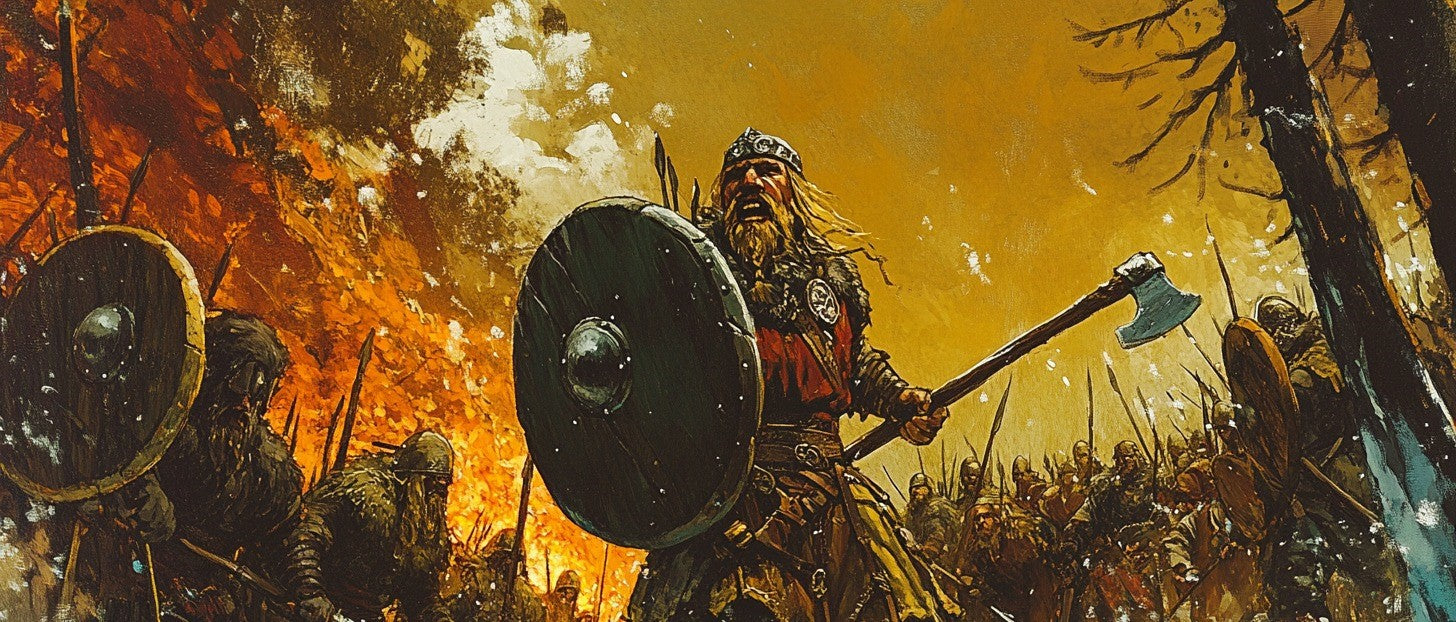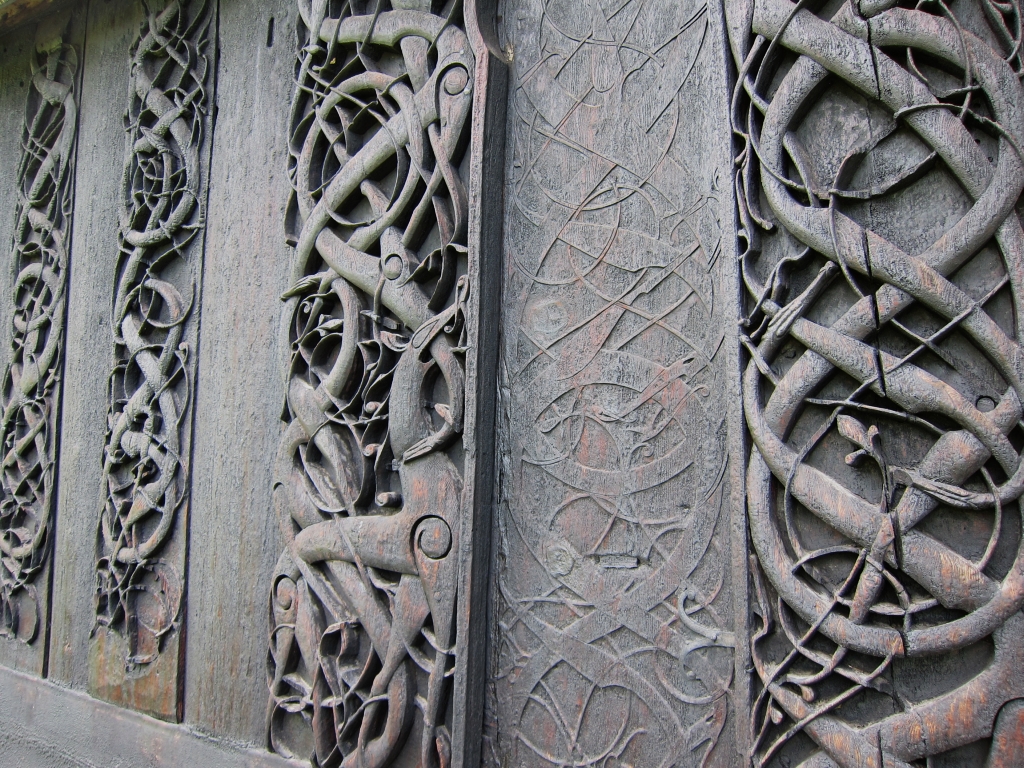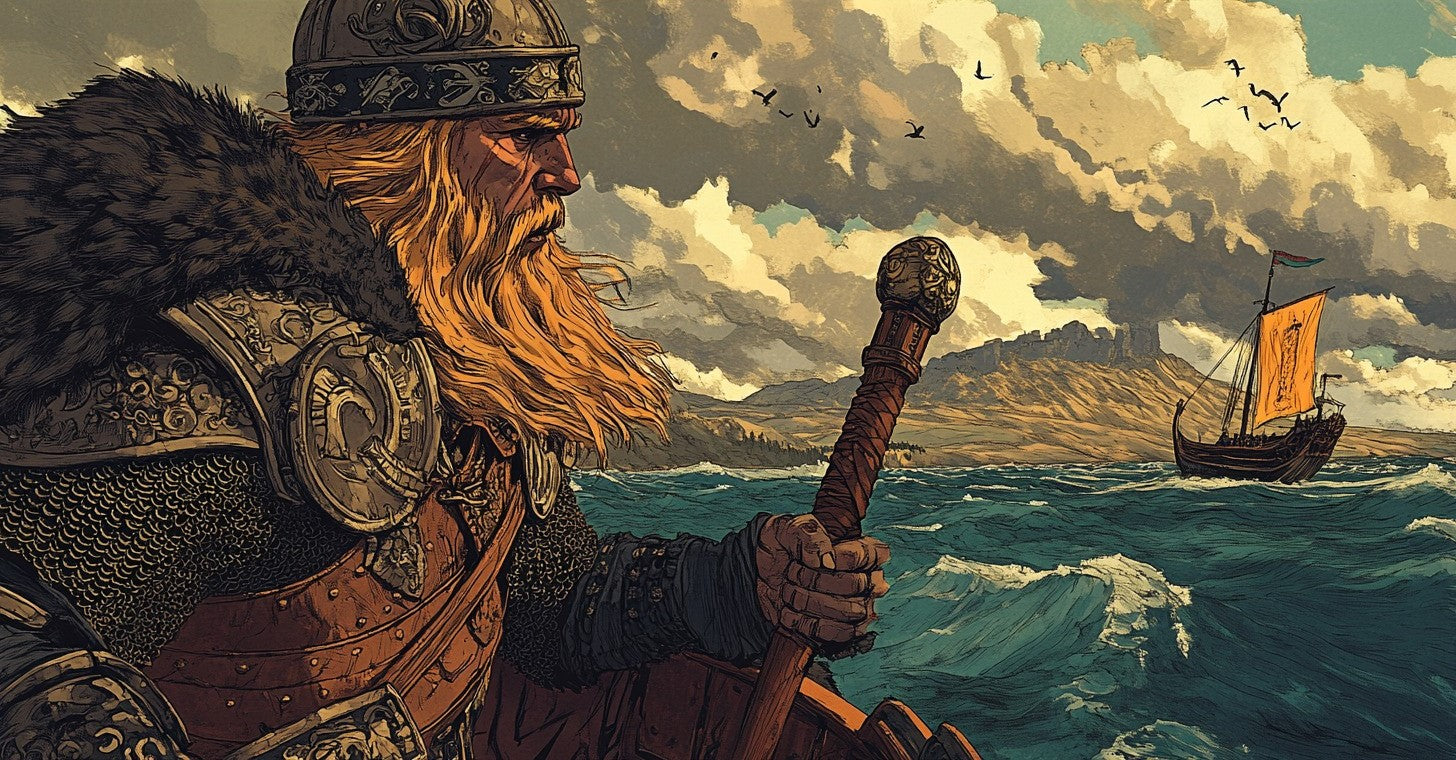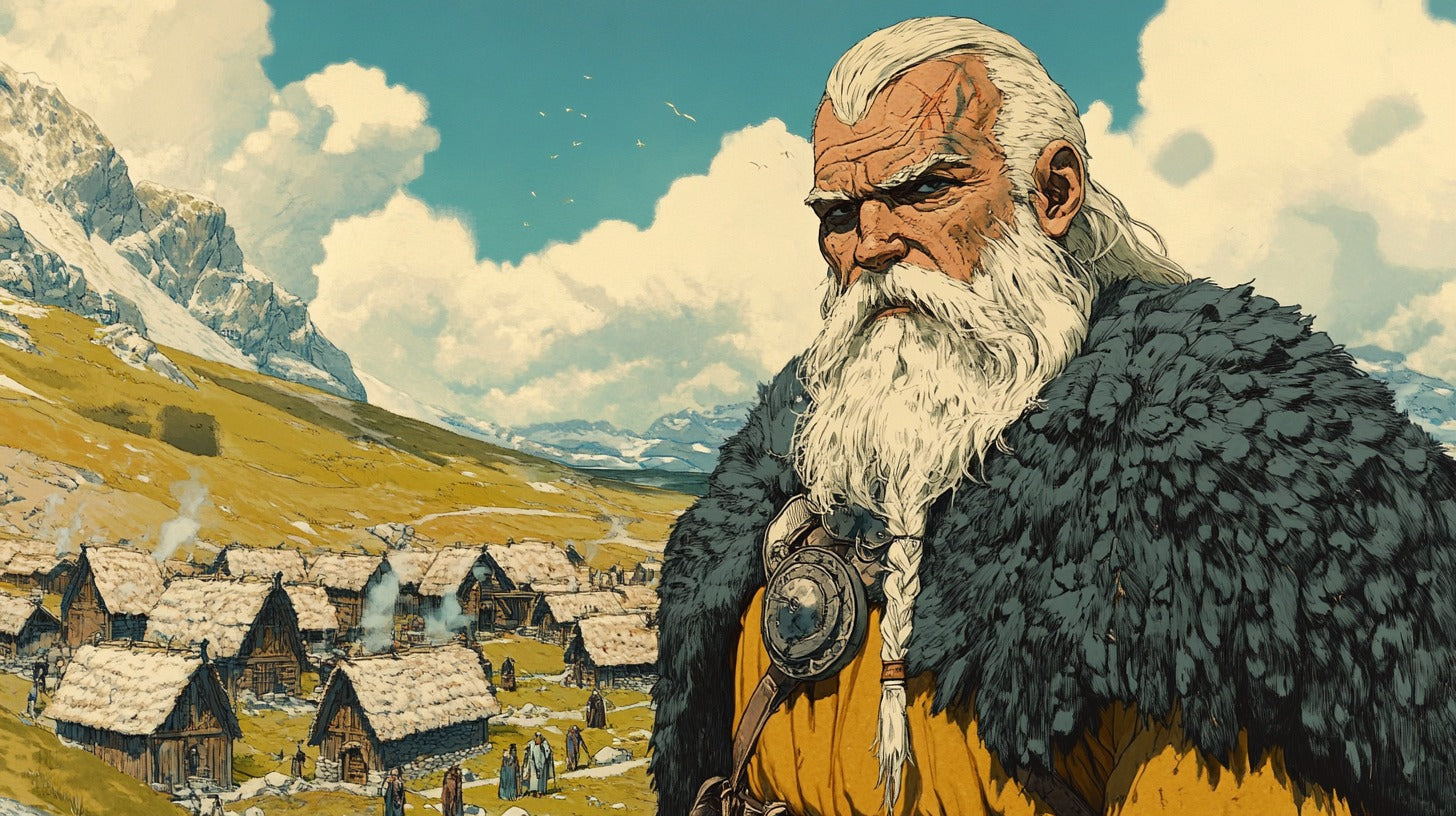
The Viking Age: A Saga of Raids, Exploration, and Cultural Impact
The Viking Age remains one of history's most fascinating periods, marked by a profound expansion of Norse influence through relentless raiding, expansive trading networks, and daring exploration. Spanning from 793 to 1066 AD, this era saw Norsemen, often synonymous with Vikings, carve out a legacy that still resonates today. This complete guide will take you on a journey through time, exploring the intricacies of Norse society, Viking conquests, and the enduring impact they left behind.
Origins of the Viking Era
The Viking Age emerged from the fjords of Scandinavia in the late 8th century. But what sparked this remarkable period of expansion? To understand the Vikings, we must first delve into the Norse society from which they sprang.

The Gjermundbu helmet, the most well-preserved of the five known Viking-Age helmets / Photo: Cultural History Museum Oslo
Norse Mythology and Its Influence
Like the roots of Yggdrasil, the great world tree, Norse mythology ran deep in Scandinavian culture. The gods of Asgard – Odin, Thor, and Freya – were not distant figures, but active participants in the lives of mortals. Their tales of valor, trickery, and fate shaped the Norse worldview, inspiring both their art and their actions.
The mythology wasn't merely a set of stories; it was a living, breathing force that guided Norse morality and ambition. The concept of Valhalla, the great hall where fallen warriors feasted with Odin, instilled a fearlessness in battle that would become legendary among the Vikings. The Norse creation myth, with its emphasis on chaos and order, mirrored the Scandinavians' own struggle to carve civilization out of the harsh Nordic landscape.
Social Structure in Norse Society
Norse society was far from the chaotic free-for-all often portrayed in popular culture. Like a well-crafted longship, it was structured with purpose and precision. At the top sat the jarls, the nobility who owned vast swathes of land. Below them were the karls, free men who formed the backbone of society as farmers, craftsmen, and warriors. At the bottom were the thralls, slaves captured in raids or born into bondage.
This hierarchical system was not entirely rigid, however. A successful karl could amass enough wealth to rise in status, while a jarl who failed to maintain his power could fall. This social mobility, though limited, added a dynamic element to Norse society that contributed to the expansionist drive of some Norsemen, leading them to become Vikings.
The Great Viking Expansion
The Viking expansion was like a great tidal wave, sweeping across Europe and beyond. It reshaped political landscapes, redrew maps, and left an enduring cultural impact that resonates to this day.

A Map of Viking expansion across Europe between the 8th and 11th centuries, the yellow colour correspondong to the expansion of the Normans / Image: Max Naylor
Reasons Behind Viking Raids
What drove some Norsemen to become Vikings, setting sail for distant shores? The answer, like a Norse riddle, is complex. Population pressure in Scandinavia, with its limited arable land, certainly played a role. The lure of wealth from prosperous monasteries and towns across Europe was another significant factor. But perhaps most importantly, the Viking raids were a way for young men to prove their worth and gain fame and fortune.
The raids were not merely acts of violence, but calculated moves in a grand strategy of expansion and wealth accumulation. They were the opening gambits in a game of power that would see Viking influence spread far and wide.
Notable Viking Expeditions

The raid on Lindisfarne in 793 CE marked the beginning of the Viking Age. Norse warriors attacked the holy island's monastery, shocking Christian Europe. This violent assault on an important religious center signaled the start of Viking expansion and raids across the British Isles and beyond.
Exploration of North America
Long before Columbus set sail, Norse longships had already touched the shores of North America. Led by Leif Erikson, son of Erik the Red, Norse explorers established a settlement in Newfoundland around the year 1000. They called this new land Vinland, and though their stay was brief, it marked a monumental achievement in the annals of exploration.
The journey to Vinland was no small feat. It required not only exceptional seamanship but also the courage to sail into the unknown. The saga of this expedition, passed down through generations, speaks to the Viking spirit of adventure and their unquenchable thirst for discovery.

Leif Eriksson Discovers America by Hans Dahl
Conquest of England
The Viking conquest of England was a saga worthy of the skalds. It began with raids in the late 8th century and culminated in the rule of Cnut the Great, who became king of England, Denmark, and Norway in the 11th century. The Vikings' impact on England was profound, influencing language, law, and culture in ways that are still evident today.
The strategies employed in this conquest were as varied as they were effective. From lightning raids to political maneuvering, the Vikings displayed a sophistication that went far beyond mere brute force. The Danelaw, a region of England under Norse rule, became a melting pot of Anglo-Saxon and Norse cultures, creating a unique blend that would shape English identity for centuries to come.
Norse Ships and Navigation
At the heart of Viking expansion lay the Norse mastery of shipbuilding and navigation. These skills were the wind in their sails, propelling them to distant shores and new conquests.

Longships: The Key to Viking Success
The Norse longship was a marvel of engineering, a perfect synthesis of form and function. With its shallow draft, it could navigate both open seas and inland waterways. Its symmetrical design allowed it to reverse direction without turning, a crucial advantage in both exploration and warfare. The longship was more than just a vessel; it was a symbol of Norse power and technological prowess.
The construction of these ships was a communal effort, requiring specialized skills passed down through generations. From the selection of the right wood to the intricate carving of the dragon head at the prow, every aspect of shipbuilding was imbued with cultural significance.

Close up image of the prowl of the Oseberg Viking ship, considered the best preserved and most significant Nordic ship from the Viking Age
Navigation Techniques
How did Norse seafarers find their way across vast stretches of open ocean? Their navigation techniques were a blend of careful observation, accumulated knowledge, and perhaps a touch of the supernatural. They used the sun and stars as guides, observed the flight patterns of birds, and may have employed a mysterious "sunstone" to determine direction on cloudy days.
These techniques allowed Viking navigators to undertake voyages that seemed impossible to their contemporaries. Their ability to navigate in harsh conditions gave them a significant advantage in both trade and warfare, enabling them to strike with surprise and retreat with impunity.
Daily Life in Norse Society
While tales of Viking raids and conquests dominate our perception, daily life in Norse society was a complex tapestry of work, family, and tradition.

Recreation of a Viking-era farmstead known as Þjóðveldisbærinn. This structure represents a faithful reproduction of Stöng, a medieval Nordic longhouse. Such buildings served as the heart of a prominent Viking farmer's estate during the Middle Ages, often functioning as both living quarters and storage facilities / Photo: Thomas Ormston
Norse Homes and Settlements
Norse settlements were a far cry from the chaos often depicted in popular culture. They were well-organized communities centered around longhouses, large wooden halls that served as both home and social center. These longhouses were marvels of insulation and space utilization, designed to withstand the harsh Nordic winters.
Archaeological evidence reveals a society that valued comfort and aesthetics alongside functionality. The layout of Norse towns shows a sophisticated understanding of urban planning, with designated areas for crafts, trade, and religious ceremonies.
Food and Drink
The Norse diet was as diverse as their influence. While meat and fish were staples, they also consumed a variety of grains, vegetables, and dairy products. The harsh climate necessitated food preservation techniques like smoking and pickling, skills that the Norse honed to perfection.
Mead, the famed honey wine, flowed freely during feasts and celebrations. These gatherings were not mere indulgences, but important social events that strengthened community bonds and allowed for the exchange of news and ideas.
Clothing and Fashion
Norse clothing was both practical and stylish, designed to withstand the harsh Nordic climate while also displaying status and personal taste. Wool and linen were the primary materials, often dyed in vibrant colors. Jewelry played a significant role in Norse fashion, with intricate brooches, arm rings, and necklaces serving as both adornment and portable wealth.
The image of the horned helmet, while iconic, is a historical misconception. Real Viking helmets were practical affairs, designed for protection rather than intimidation. This disparity between popular perception and historical reality is a reminder of how much there is still to learn about Norse culture.
Viking Warfare and Weapons
The image of the fierce Viking warrior is not without foundation. Viking military prowess was legendary, combining advanced weaponry with innovative tactics.

A Viking sword discovered in Repton, Mercia. Dating back to the Viking Age, it is believed to have been wielded by a Norsemen part of the Great Heathen Army / Photo: Roger from Derby
Battle Tactics and Strategies
Viking battle strategies were far more sophisticated than the berserker charges often depicted in fiction. They employed a variety of formations, including the famous "shield wall," a tightly-packed defensive line that could withstand heavy attacks. Their ability to strike quickly from their ships, known as hit-and-run tactics, gave them a significant advantage over less mobile forces.
The Vikings also showed remarkable adaptability in their military campaigns. When facing fortified towns, they quickly learned siege warfare techniques, demonstrating an ability to evolve their strategies as needed.
Famous Viking Warriors
Names like Ragnar Lothbrok, Ivar the Boneless, and Bjorn Ironside have achieved near-mythical status. While separating fact from fiction can be challenging, these figures represent the Viking ideal of the warrior-leader. They were not just fighters, but also charismatic commanders who inspired loyalty and struck fear into the hearts of their enemies.
The sagas that tell their stories are more than just entertainment; they provide valuable insights into Viking values and the qualities they admired in their leaders.
Trade and Commerce in the Norse World
While some Norsemen became Vikings and raiders, many others were accomplished traders, establishing a vast network of commercial relationships that spanned continents.

Collapsible scale, weights, and leather pouch from Valsgärde boat grave 12, 10th century / Photo: Joe Mabel, CC BY-SA 4.0
Important Trade Routes
Norse trade routes stretched from the Arctic Circle to the Mediterranean, and from the shores of North America to the markets of Baghdad. They traded in a wide variety of goods, including furs, amber, honey, slaves, and exotic items from distant lands. These trade networks not only brought wealth to Scandinavia but also facilitated cultural exchange on an unprecedented scale.
The establishment of trading posts often led to more permanent settlements, contributing to the spread of Norse influence. Cities like Dublin and Kiev owe their foundations to Norse traders.
Norse Coins and Currency
The Norse engagement with international trade led to the development of sophisticated monetary systems. While they initially relied on hacksilver (pieces of silver used as currency), they soon began minting their own coins. These coins often bore the names of Norse rulers, serving as both currency and propaganda.
The study of Norse coins provides valuable insights into their economic systems, political structures, and even artistic sensibilities. It's a testament to the complexity of Norse society that goes far beyond the stereotype of simple plunderers.
Art and Craftsmanship
Norse art and craftsmanship reflect a culture that valued beauty as much as it did strength. Their artistic legacy continues to inspire and amaze to this day.

Detail of the 'Urnes-style' wood carvings at Norway's Urnes Stave Church. This 12th-century UNESCO site showcases intricate animal designs, representing late Viking art and blending Norse, Celtic, and Romanesque influences in its unique architecture / Photo: Bosc d'Anjou
Intricate Metalwork and Jewelry
Norse metalwork is renowned for its intricate designs and superior craftsmanship. From delicate filigree work to bold animal motifs, Norse jewelry showcases a level of artistry that belies their reputation as mere barbarians. These pieces were not just decorative; they often held deep symbolic meaning, reflecting the wearer's status, beliefs, and affiliations.

The Mammen Axe, discovered in a Danish chieftain's grave from the 10th century, is a remarkable example of Viking craftsmanship. This ornate battle axe features intricate silver inlays, showcasing the artistic skill of Norse metalworkers during the late Viking Age / Photo: National Museum of Denmark
The famous "gripping beast" motif, where interlaced animals grasp each other with claws and jaws, is a prime example of the complexity and dynamism of Norse art. It's a style that continues to influence modern designers and artists.
Runestones and Carvings
Runestones stand as enduring monuments to Norse culture. These large stones, carved with runic inscriptions and often elaborate designs, served various purposes. Some commemorated the dead, others marked territory or recounted great deeds. The runes themselves were more than just an alphabet; they were believed to hold magical properties.
Wood carving was another area where Norse artisans excelled. The intricate carvings found on everything from ship prows to household items demonstrate a level of skill and artistic vision that continues to astonish modern observers.
The End of the Viking Age
Like all great epochs, the Viking Age had to come to an end. But its conclusion was not a sudden event, but rather a gradual transformation.

Harald Hardrada, the last great Viking, met his end at the Battle of Stamford Bridge in 1066. As King of Norway, he invaded England but was defeated by Anglo-Saxon forces. This battle is often considered the end of the Viking Age / Illustration: Paganheim
Christianization of Scandinavia
The adoption of Christianity in Scandinavia marked a significant turning point. This process, which began in the 9th century and continued through the 11th, brought about profound changes in Norse society. While the transition was not always smooth, with periods of conflict between the old beliefs and the new, it ultimately led to Scandinavia's integration into the broader European Christian community.
The Christianization process didn't entirely eradicate Norse traditions, however. Many pagan customs were adapted and incorporated into Christian practice, creating a unique blend of beliefs that persisted for generations.
Legacy of the Vikings
The end of the Viking Age did not mean the end of Norse influence. Their impact on language, law, place names, and genetic makeup can still be seen across much of Europe and beyond. The Norse sagas, written down in the centuries following the Viking Age, preserved their stories and continue to captivate readers to this day.
Perhaps the most enduring legacy of the Vikings is their spirit of exploration and adventure. From their voyages to North America to their trade routes reaching Baghdad, the Vikings expanded the known world and paved the way for future explorers.
Conclusion
The Viking Age was a period of remarkable transformation, not just for Scandinavia, but for much of the world. From their revolutionary shipbuilding techniques to their far-reaching trade networks, from their fearsome military campaigns to their intricate artworks, the Vikings left an indelible mark on history.
As we've explored in this guide, the reality of Norse society and the Viking phenomenon was far more complex and nuanced than popular stereotypes suggest. They were not just raiders, but also traders, explorers, artists, and innovators. Their influence stretched far beyond their Scandinavian homeland, shaping the course of European and world history in ways we are still uncovering.
The story of the Vikings is a reminder of the power of human ambition, ingenuity, and adaptability. It's a saga that continues to unfold as new archaeological discoveries and historical research shed light on this fascinating period. As we look back on the Viking Age, we find not just tales of conquest and plunder, but a rich tapestry of human experience that continues to resonate with us today.
FAQs
- Were Viking helmets really horned?
No, contrary to popular belief, Viking helmets did not have horns. This misconception likely originated from 19th-century artistic depictions.
- Did Norse women participate in raids?
While not common, there is some evidence suggesting that some Norse women may have participated in raids and battles.
- How far did Viking explorations reach?
Viking explorations reached as far west as North America, as far east as the Caspian Sea, and as far south as North Africa.
- What language did the Norse people speak?
The Norse people spoke Old Norse, which is the ancestor of modern Scandinavian languages.
- How did Viking navigators find their way at sea?
Vikings used a combination of techniques including celestial navigation, observing nature (like bird flight patterns), and possibly a 'sunstone' for navigation on cloudy days.
References
Haywood, J. (2016). Northmen: The Viking Saga, AD 793-1241. St. Martin's Press.
Price, N. (2020). Children of Ash and Elm: A History of the Vikings. Basic Books.
Winroth, A. (2014). The Age of the Vikings. Princeton University Press.
Fitzhugh, W. W., & Ward, E. I. (2000). Vikings: The North Atlantic Saga. Smithsonian Institution Press.
Graham-Campbell, J. (2013). The Viking World. Frances Lincoln.
"Cultural History (historisk) Museum Oslo. VIKINGR Norwegian Viking-Age Exhibition 08 Iron helmet from Gjermundbu (Gjermundbuhjelmen). Best-preserved viking helmet, grave find, destroyed in funeral. Equestrian warrior 950-1000. 4667" by Wolfmann is licensed under CC BY-SA 4.0.
"The Vikings Begin 24 - collapsible scale, weights, and leather pouch, from Valsgärde boat grave 12, 10th century" by Joe Mabel is licensed under CC BY-SA 4.0.
"Stöng Viking Longhouse" by Thomas Ormston (Ormstont) is licensed under CC BY-SA 3.0.
"Derby Museum Viking Sword" by Roger from Derby, UK is licensed under CC BY 3.0.
"Urnes stave church 03" by Bosc d'Anjou is licensed under CC BY-NC-SA 2.0.








